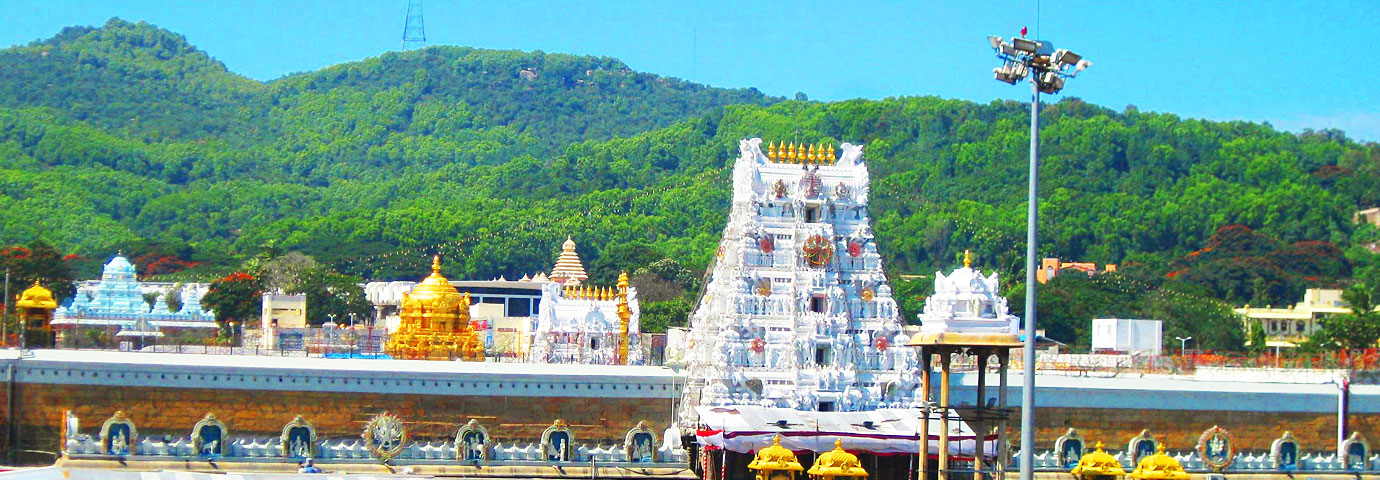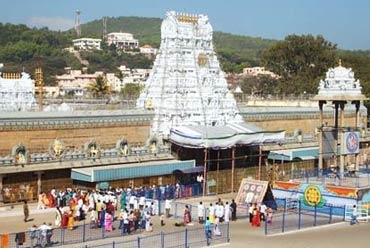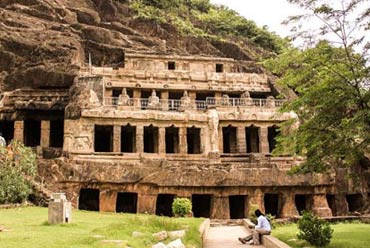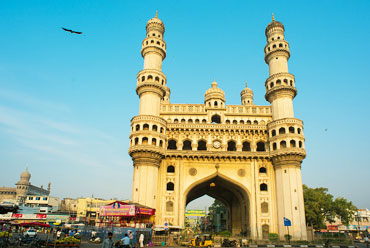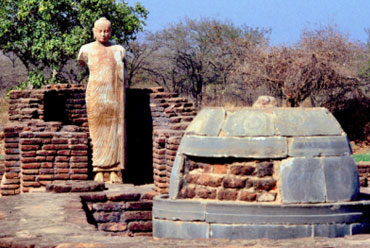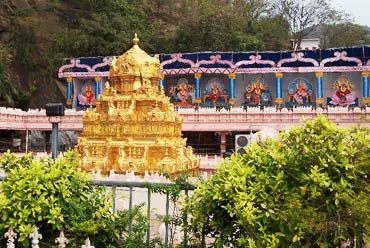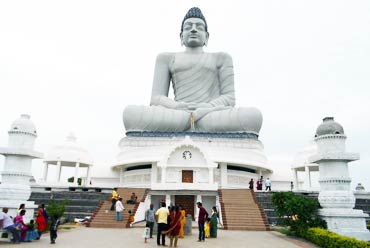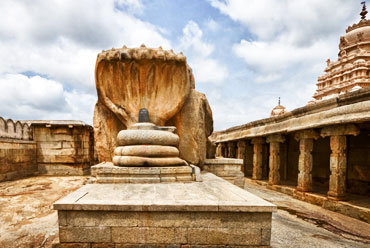Tourist Attractions in Tirupati
The ancient and sacred temple of Sri Venkateswara is located on the seventh peak, Venkatachala of the Tirupati Hills, and lies on the southern banks of Sri Swami Pushkarini. Lord Venkateswara is also called the Lord of the Seven Hills. The benefits acquired by a pilgrimage to Venkatachala are mentioned in Rig Veda and Asthadasa Puranas. Here, Sri Venkateswara is described as the great bestower of boons. There are several legends associated with the manifestation of the Lord at Tirumala. The temple has its origins in Vaishnavism. The sanctum sanctorum, which houses the awe-inspiring idol of the Lord of the Seven Hills, is situated in the main temple complex of Tirumala.
Sri Varahaswami Temple in Tirumala is to the north of the Sri Venkateswara temple, on the banks of Swami Pushkarini. According to legend, Tirumala was originally the Adi Varaha Kshetra or the place belonging to Sri Adi Varahaswami. Lord Sri Venkateswara took up residence here, with the permission of Sri Varahaswami. According to Brahma Purana, naivedyam (food offered to God) should first be offered to Sri Varahaswami. Pilgrims should visit Sri Varahaswami temple before Sri Venkateswara temple. The idol of Sri Varahaswami in Tirumala is that of Adi Varaha.
Sri Anjaneyaswami Temple is located opposite the Sri Varahaswami temple on the northeastern banks of the Swami Pushkarini. It was constructed during the Mahant's period. The idol's hands are joined in supplication (in the Anjali posture). Sri Anjaneyaswami is believed to be a bestower of boons and a protector from all evils.
Swami Pushkarini, believed to be a pleasure tank of Lord Vishnu in Vaikuntham, is adjacent to the Sri Venkateswara temple. A bath in the Swami Pushkarini is believed to cleanse pilgrims of their sins and bestow temporal prosperity. Pilgrims bathe here before entering the main temple. Other teerthams include Akasaganga Teertham, Papavinasanam Teertham, Pandava Teertham, Kumaradhara Teertham, Tumbhuru Teertham, Ramakrishna Teertham, Chakra Teertham, Vaikuntha Teertham, Sesha Teertham, Sitamma Teertham, Pasupu Teertham, Japali Teertham, and Sanaka Sanandana Teertham.
Sri Govindarajaswami Temple is an important temple in Tirupati. It has an imposing gopuram that can be seen from a distance. Saint Ramanujacharya consecrated the temple in AD 1130. The sub-temples in its premises include Sri Parthasarathiswami Temple, Sri Kalyana Venkateswaraswami Temple, Sri Andal Temple, Sri Salai Nachiyar Ammavari Temple, Sri Ramanuja Temple, Sri Vyasaraya Anjaneyaswami Temple, Sri Tirumangai Alwar Temple, Sri Kurath Alwar Temple, Sri Madhurakavi Alwar Temple, Sri Chakrathalwar Temple, Sri Mudal Alwar Temple, Sri Manavala Mahamuni Temple, Sri Vedantha Desikar Temple and many others.
Sri Kodandaramaswami Temple is situated in the heart of Tirupati town. The presiding deities are Sita, Rama and Lakshmana. A Chola king built this temple during the tenth century AD. The temple of Anjaneyaswami, which is directly opposite, is a sub-shrine of this temple. According to legend, this temple commemorates the visit of Sri Rama to Tirupati.
Sri Kapileswaraswami Temple is the only temple dedicated to Lord Siva, in the pantheon of Vaishnava temples in Tirupati. It is situated about 3 km to the north of Tirupati, at the foot of the Tirumala Hills. The sacred waterfall called Kapila Teertham or Alwar Teertham is located here.
Sri Prasanna Venkateswaraswami Temple is located in Appalayagunta, 14 km from Tirupati. Legend has it that Sri Venkateswaraswami, after marrying Sri Padmavathi Ammavaru, blessed Sri Siddeswara and other sages here.
The temple constructed by the Rajas of Karvetinagar consists of a shrine for Anjaneyaswami. Devotees, for relief from chronic diseases, worship the imposing image of the wind-god. There are also idols of Goddess Padmavathi and Sri Andal here.
Sri Chennakesavaswami Temple is located in Tallapaka village at a distance of 100 km from Tirupati, which is the birthplace of Sri Annamacharya, the Sankeertana Acharyulu. The temple was constructed and administered by the Matti Rajas about 1,000 years ago. The sub-temples here are Sri Kamakshi Sameta Temple, Sri Siddeswaraswami Temple, and Sri Gopalaswami Sameta Chakrathalwar Temple.
Sri Kariya Manikyaswami Temple or Sri Perumala Swami Temple is located in Nagiri, 51 km from Tirupati. It is believed that Lord Vishnu killed Makara, a crocodile, and saved Gajendra, an elephant at this place.
Sri Annapurna Sameta Kasi Visweswaraswami Temple is located in the Bugga Agraharam village, 56 km from Tirupati. The temple is on the banks of Kusasthali River.
Places Around Tirupati
Tiruchanoor, also known as Alamelumangapuram, is about 5 km from Tirupati. The temple of Sri Padmavathi Devi or Goddess Lakshmi, the consort of Lord Sri Venkateswara, is situated here. It is said that a visit to Tirumala is fruitful only after visiting the Sri Padmavathi Devi temple. The sub-temples in its premises include the Sri Krishnaswamy Temple, Sri Sundara Rajaswamivari Temple, and Sri Suryanarayana Swamivari Temple.
Sri Kalyana Venkateswaraswami temple is at Srinivasa Mangapuram, situated 12 km to the west of Tirupati. According to legend, Lord Venkateswara stayed here after his marriage with Sri Padmavathi Devi, before proceeding to Tirumala.
Sri Kalyana Venkateswaraswami temple, at Narayanavanam, is 40 km from Tirupati. Sri Kalyana Venkateswaraswami is the main deity here. There are four sub-temples here, which include Sri Padmavathi Ammavari temple, Sri Andal Ammavari temple, Sri Sita Lakshmana Sameta Ramulavari temple, and Sri Ranganayakula Swami temple. Besides these, there are five other temples attached to Sri Kalyana Venkateswaraswami temple, namely, Sri Parasareswara Swami temple, Sri Veerabhadra Swami temple, Sri Sakti Vinayaka Swami temple, Sri Agastheeswara Swami temple, and Sri Avanakshamma temple.
Sri Veda Narayanaswami temple is located in Nagalapuram, 70 km southeast of Tirupati. It is believed that Lord Vishnu, in the form of Matsya, killed the demon Somakudu here, and retrieved the Vedas from the latter. The sanctum sanctorum houses an image of the Matsya form of Vishnu, with Sridevi and Bhudevi on either side. A peculiar feature of the idol is that it holds the Sudarsana Chakra in prayoga mudra, ready for release. The temple was constructed by Sri Krishnadevaraya Raya, the Vijaynagar emperor, and is a fine specimen of the Vijaynagar style of architecture. The sub-temples inside the main temple are Sri Vedavalli Tayaru temple, Sri Lakshmi Narasimha Swami temple, Sri Veeranjaneya Swami temple, Sri Bhakta Anjaneyaswami temple, and Sri Sita Lakshmana Sameta Ramulavari temple.
Sri Venugopalaswami temple is situated in Karvetinagaram, 58 km from Tirupati. The main deity of the temple is Sri Venugopalaswami with His consorts, Sri Rukmini Ammavaru and Sri Satyabhama Ammavaru. There is a sub-temple with the idol Sri Sita Ramula Pattabhishekam.

